
The Teloschistaceae are a large family of mostly lichen-forming fungi belonging to the class Lecanoromycetes in the division Ascomycota. Many members of the Teloschistaceae are readily identifiable by their vibrant orange to yellow hue, a result of its frequent anthraquinone content. The presence of these anthraquinone pigments, which confer protection from ultraviolet light, enabled this group to expand from shaded forest habitats to harsher environmental conditions of sunny and arid ecosystems during the Late Cretaceous. Collectively, the family has a cosmopolitan distribution, although members occur predominantly in subtropical and temperate regions. Although most members either live on rock or on bark, about 40 species are lichenicolous–meaning they live on other lichens.

Gyalolechia is a genus of lichen-forming fungi belonging to the family Teloschistaceae. It contains 18 species of crustose lichens.

Flavoplaca is a genus of crust-like or scaly lichens in the family Teloschistaceae. It has 28 species with a mostly Northern Hemisphere distribution.

Xanthocarpia is a genus of mostly crustose lichens in the family Teloschistaceae. It has 12 species with a largely Northern Hemisphere distribution.
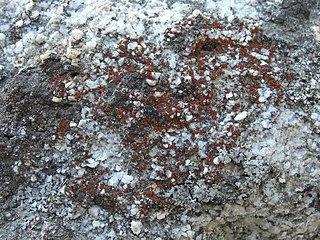
Rufoplaca is a genus of lichen-forming fungi in the family Teloschistaceae. The genus was circumscribed in 2013 by Ulf Arup, Ulrik Søchting, and Patrik Frödén, with Rufoplaca subpallida assigned as the type species.
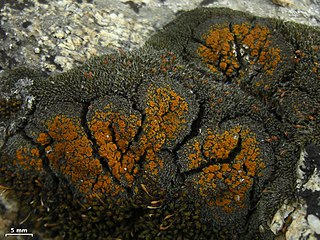
Parvoplaca is a genus of lichen-forming fungi in the family Teloschistaceae. The genus was circumscribed in 2013 by Ulrik Søchting, Patrik Frödén, and Ulf Arup.

Squamulea is a genus of lichen-forming fungi in the family Teloschistaceae. It has 15 species. The genus was circumscribed in 2013 by Ulf Arup, Ulrik Søchting, and Patrik Frödén, with Squamulea subsoluta assigned as the type species. Five species were included in the original account of the genus. The genus name alludes to the squamulose growth form of most of its species. Squamulea has a worldwide distribution; when the genus was originally created, the centre of distribution was thought to be in southwestern North America.
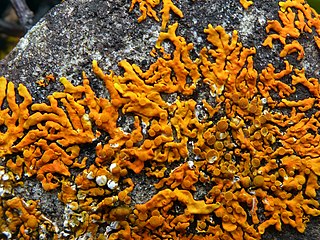
Dufourea is a genus of mostly foliose lichen species in the subfamily Xanthorioideae of the family Teloschistaceae. Species in the genus are mostly found in the Southern Hemisphere.
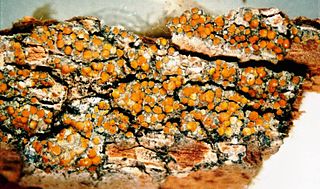
Cerothallia is a genus of crustose lichens in the family Teloschistaceae. It has four species, all of which occur in the Southern Hemisphere. The genus was circumscribed in 2013 by Ulf Arup, Patrik Frödén, and Ulrik Søchting, with Cerothallia luteoalba assigned as the type species. The type is more widely distributed, as it is also found in Europe and North America. The generic name Cerothallia means "with waxy thallus".
Sirenophila is a genus of crustose lichens in the subfamily Teloschistoideae of the family Teloschistaceae. It has four species with an Australasian distribution.
Huneckia is a genus of crustose lichens in the subfamily Caloplacoideae of the family Teloschistaceae. It has four species.

Pyrenodesmia is a genus of lichen-forming fungi in the family Teloschistaceae. The genus currently includes 23 recognized species but is believed to contain many more unnamed taxa. The genus was circumscribed in 1852 by Italian lichenologist Abramo Bartolommeo Massalongo. It is characterised by the complete absence of anthraquinones and the presence of Sedifolia-gray pigments in both the thallus and apothecia. These lichens are typically found in calcareous outcrops in the Northern Hemisphere, with biodiversity centres in the Mediterranean basin, Central Asia, and arid regions of western North America.
Villophora is a genus of lichen-forming fungi in the subfamily Teloschistoideae of the family Teloschistaceae. It has 9 species. The genus was circumscribed in 2013 by Ulrik Søchting, Ulf Arup, and Patrik Frödén. They assigned Villophora isidioclada as the type, and at that time, only species in the genus. This lichen, previously classified in Caloplaca, is found in South America, Antarctica, and some subantarctic islands. Several additional species were added to the genus in 2021. The generic name Villophora means "carrying filaments".

Wetmoreana is a genus of lichen-forming fungi in the family Teloschistaceae. It has two crustose, saxicolous (rock-dwelling) species.
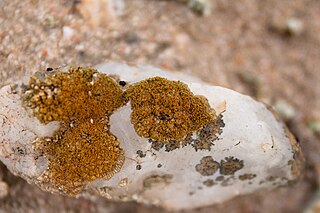
Stellarangia is a genus of lichen-forming fungi in the family Teloschistaceae. It has three species of saxicolous (rock-dwelling), crustose lichens. Species of Stellarangia are found in dry, desert areas in Namibia and South Africa.
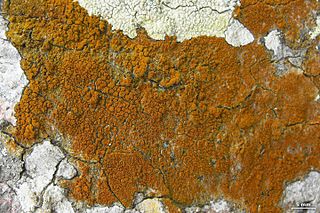
Lacrima is a genus of lichen-forming fungi in the family Teloschistaceae. It has four saxicolous (rock-dwelling), crustose species.
Teloschistopsis is a genus of lichen-forming fungi in the family Teloschistaceae. It has three species.
Follmannia is a genus of lichen-forming fungi in the family Teloschistaceae. It has three species. All three species are crustose lichens, and all occur in South America.
Gondwania is a genus of lichen-forming fungi in the subfamily Xanthorioideae of the family Teloschistaceae. It has three species. The genus was circumscribed by lichenologists Ulrik Søchting, Patrik Frödén, and Ulf Arup. The type species is G. cribrosa, a species that was first named Polycauliona cribrosa by Auguste-Marie Hue in 1909. The genus name refers to the ancestral supercontinent Gondwana.
Solitaria is a fungal genus in the family Teloschistaceae. It contains a single species, the corticolous (bark-dwelling), crustose lichen Solitaria chrysophthalma.












